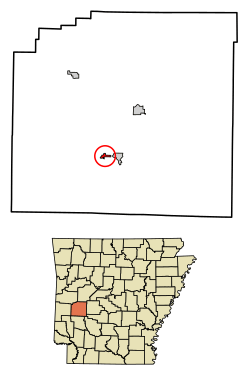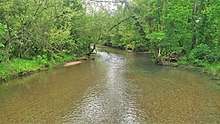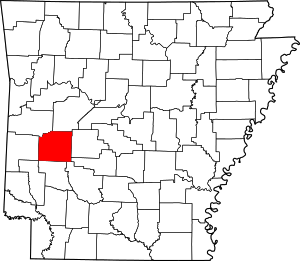Black Springs, Arkansas
Black Springs is a town in Montgomery County, Arkansas, United States. The population was 114 at the 2000 census.
Black Springs, Arkansas | |
|---|---|
 Black Springs Community Center | |
 Location of Black Springs in Montgomery County, Arkansas. | |
| Coordinates: 34°27′40″N 93°42′46″W[1] | |
| Country | United States |
| State | Arkansas |
| County | Montgomery |
| Area | |
| • Total | 0.45 sq mi (1.16 km2) |
| • Land | 0.45 sq mi (1.15 km2) |
| • Water | 0.00 sq mi (0.01 km2) |
| Elevation | 774 ft (236 m) |
| Population (2010) | |
| • Total | 99 |
| • Estimate (2019)[3] | 92 |
| • Density | 206.74/sq mi (79.79/km2) |
| Time zone | UTC-6 (Central (CST)) |
| • Summer (DST) | UTC-5 (CDT) |
| FIPS code | 05-06730 |
Geography

Black Springs is located at 34°27′40″N 93°42′46″W (34.4612118, -93.7126919).[1][4]
According to the United States Census Bureau, the town has a total area of 1.1 km2 (0.4 mi2), all land.
Demographics
| Historical population | |||
|---|---|---|---|
| Census | Pop. | %± | |
| 1880 | 67 | — | |
| 1940 | 97 | — | |
| 1970 | 72 | — | |
| 1980 | 92 | 27.8% | |
| 1990 | 97 | 5.4% | |
| 2000 | 114 | 17.5% | |
| 2010 | 99 | −13.2% | |
| Est. 2019 | 92 | [3] | −7.1% |
| U.S. Decennial Census[5] 2014 Estimate[6] | |||
As of the census[7] of 2000, there were 114 people, 46 households, and 33 families residing in the town. The population density was 102.4/km2 (262.8/mi2). There were 52 housing units at an average density of 46.7/km2 (119.9/mi2). The racial makeup of the town was 97.37% White, and 2.63% from two or more races.
There were 46 households, out of which 28.3% had children under the age of 18 living with them, 65.2% were married couples living together, 4.3% had a female householder with no husband present, and 26.1% were non-families. 19.6% of all households were made up of individuals, and 17.4% had someone living alone who was 65 years of age or older. The average household size was 2.48 and the average family size was 2.82.
In the town, the population was spread out, with 25.4% under the age of 18, 2.6% from 18 to 24, 30.7% from 25 to 44, 13.2% from 45 to 64, and 28.1% who were 65 years of age or older. The median age was 40 years. For every 100 females, there were 111.1 males. For every 100 females age 18 and over, there were 107.3 males.
The median income for a household in the town was $27,000, and the median income for a family was $25,250. Males had a median income of $26,875 versus $15,625 for females. The per capita income for the town was $12,312. There were 16.1% of families and 23.7% of the population living below the poverty line, including 34.8% of under eighteens and 10.3% of those over 64.
Government
Town government in Arkansas is divided into a mayor, a board of five aldermen, and a recorder-treasurer.[8] Board meetings are held on the second Tuesday of each month at the Black Springs Community Center.[9]
Politics
In Congress, Arkansas has been represented by two Republican senators (John Boozman and Tom Cotton) since January 3, 2015, ending a long history of Democratic hegemony. In the House of Representatives, Black Springs and Montgomery County is within the Arkansas 4th district, which contains almost the entire southwestern half of the state. The Arkansas 4th has been represented by Bruce Westerman since 2015.
In the Arkansas Senate, Black Springs is within the 10th District. The district encompasses almost all of the Ouachita Mountain counties. The 10th has been represented by Larry Teague (D) of Nashville since 2013. In the Arkansas House of Representatives, Black Springs is within the 20th District, which contains Montgomery, Polk, and Sevier counties. The 20th has been represented by John Maddox (R) of Mena since 2017.[10]
Infrastructure
Utilities
Entergy Arkansas is the sole provider of electricity in almost all of Montgomery County, including Black Springs.[11]
Notable people
- Boyd Anderson Tackett, U.S. Representative for Arkansas's 4th congressional district from 1949 to 1953 and 1952 Democratic gubernatorial nominee
References
- "2019 U.S. Gazetteer Files". United States Census Bureau. Retrieved June 30, 2020.
- "Population and Housing Unit Estimates". United States Census Bureau. May 24, 2020. Retrieved May 27, 2020.
- "US Gazetteer files: 2010, 2000, and 1990". United States Census Bureau. 2011-02-12. Retrieved 2011-04-23.
- "Census of Population and Housing". Census.gov. Retrieved June 4, 2015.
- "Annual Estimates of the Resident Population for Incorporated Places: April 1, 2010 to July 1, 2014". Archived from the original on 2015-05-22. Retrieved June 4, 2015.
- "U.S. Census website". United States Census Bureau. Retrieved 2008-01-31.
- Staff of the Encyclopedia of Arkansas History & Culture (December 17, 2013). "Municipal Designations". Encyclopedia of Arkansas History & Culture. Little Rock: Butler Center for Arkansas Studies at the Central Arkansas Library System.
- Staff of the Arkansas Municipal League. "Black Springs". Little Rock: Arkansas Municipal League. Retrieved May 6, 2019.
- Arkansas Economic Development Institute. Arkansas District Finder (Map). Various. Little Rock: University of Arkansas at Little Rock. Retrieved May 6, 2019.
- Electric Utility Service Territories (polygon) (Map) (Update ed.). Arkansas GIS Office. October 16, 2014 [June 5, 2009]. Retrieved May 6, 2019.
